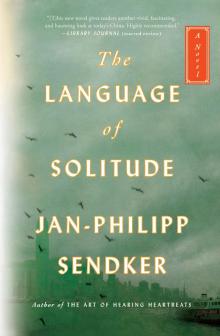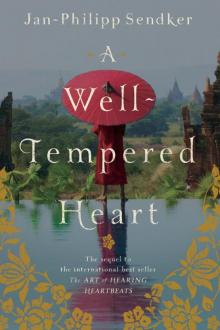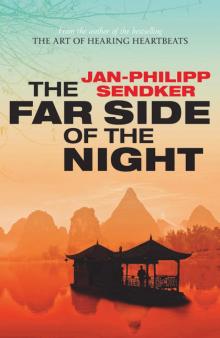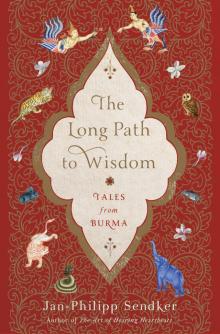- Home
- Jan-Philipp Sendker
The Long Path to Wisdom
The Long Path to Wisdom Read online
ALSO BY JAN-PHILIPP SENDKER
The Art of Hearing Heartbeats
A Well-Tempered Heart
Copyright © 2017 by Jan-Philipp Sendker
Originally published in German as Das Geheimnis des alten Mönches:
Märchen und Fabeln aus Burma in 2017 by Karl Blessing Verlag, Munich
Translation copyright © 2018 by Jan-Philipp Sendker
Production editor: Yvonne E. Cárdenas
Text Designer: Jennifer Daddio
All rights reserved. No part of this publication may be reproduced or transmitted in any form or by any means, electronic or mechanical, including photocopying, recording, or by any information storage and retrieval system, without written permission from Other Press LLC, except in the case of brief quotations in reviews for inclusion in a magazine, newspaper, or broadcast. For information write to Other Press LLC, 267 Fifth Avenue, 6th Floor, New York, NY 10016. Or visit our Web site: www.otherpress.com.
The Library of Congress has cataloged the printed edition as follows:
Names: Sendker, Jan-Philipp, author. | Karnath, Lorie, author. | Sendker, Jonathan, 1997–author. | Liesener, Lisa, translator. | Wiliarty, Kevin, translator.
Title: The long path to wisdom : tales from Burma / Jan-Philipp Sendker; with Lorie Karnath and Jonathan Sendker; translated from the German by Lisa Liesener and Kevin Wiliarty.
Other titles: Geheimnis des alten Mönches. English.
Description: New York : Other Press, 2018. | “Originally published in German as Das Geheimnis des alten Mönches : Märchen und Fabeln aus
Burma in 2017 by Karl Blessing Verlag, Munich”—Title page verso.
Identifiers: LCCN 2018003774 (print) | LCCN 2018018171 (ebook) | ISBN 9781590519653 (Ebook) | ISBN 9781590519646 (paperback)
Subjects: LCSH: Folk literature, Burmese. | Fairy tales—Burma. | BISAC: LITERARY COLLECTIONS / Asian. | FICTION / Fairy Tales, Folk Tales, Legends & Mythology. | FICTION / Short Stories (single author).
Classification: LCC GR309 (ebook) | LCC GR309 .S4613 2018 (print) | DDC 398.209591—dc23
LC record available at https://lccn.loc.gov/2018003774
Ebook ISBN 9781590519653
v5.3.2
a
FOR
our parents
Contents
Cover
Also by Jan-Philipp Sendker
Title Page
Copyright
Dedication
Preface
My Burma
The Little Boy and the Tiger
The Old Monk’s Secret
The Four Marionettes
How the People of Bagan Started to Lie
The Sorrowbird
Five Silver Coins
The Skylark’s Revenge
Saw Min Kyi and the Ruby
The Night the Moon Fell into the Well
Little Monkey Goes Looking for Trouble
The Farmer’s Revenge
The Fisherman and His Wife
The Pious Queen
Nan Kyar Hae and the Guardian Spirit
A Battle Between Two Sculptors
The Village of Endless Sermons
The Long Journey
On Gratitude
The Traveling Threesome
How the Hare Became a Judge
Mouse and Elephant
How the Thrush Lost Her Colorful Plumage
The Just King
The Blacksmith’s Children
The Little Snail
A Troop of Monkeys and One Greedy Neighbor
Nan Ying and Her Little Brother
The Fear Virus
On the Rationality of Astrology
On Sharing
Life’s Many Tribulations
The Power of Karma
The Boy with the Harp
The Honest Merchant
The Magic Comb
A Mother’s Warning
The Timid Son
The Grateful Serpent
The Starving Orphans
The Flood
The Wise Teacher and His Student Maung Pauk Kyaing
The Omen
How to Spell “Buffalo”
The Tale of Two Merchants
The White Crow and Love
Mu Yeh Peh and the Wages of Love
The Beautiful Woman and the Lazy Dimwit
The Fisherman’s Reward
The Best Storyteller
The Crocodile and the Monkey
The Clever Monkeys
Three Women and One Man
The Story of the Father and His Son, Or Where the Wind and Water Got Their Power
The Long Path to Wisdom
Epilogue
Acknowledgments
Authors
Preface
hen the American author Lorie Karnath approached me with the idea of collaborating on a book of Burmese folk tales, fables, and parables, I knew right away that I was interested.
Since 1995 I had visited the former British colony dozens of times, first as a journalist, later as an author. Time and time again during my research for the novels The Art of Hearing Heartbeats and A Well-Tempered Heart I came across stories from the realm of fairy tales and legends. They piqued my curiosity because their often moving narratives exposed the rich mythologies of the various ethnicities of Burma, the spirituality of its people, and the impact of centuries of Buddhist thought. Monks and monasteries figured prominently, as did the firmly rooted belief in reincarnation. I was surprised how often characters would die only to return in a next life, either to right wrongs or to wreak havoc.
Some tales had no apparent moral or were so alien, so bizarre, that I found them impossible to classify. Others reminded me of the fairy tales of my own childhood except that monkeys, tigers, elephants, and crocodiles stood in for hedgehogs, donkeys, or geese. The lessons they attempted to convey resembled those of the Brothers Grimm or of Hans Christian Andersen, and they highlighted the great extent to which all the world’s cultures draw upon a universal font of human wisdom.
Lorie Karnath is no less acquainted with Burma and its people than I. She was there for the first time in the early nineties, a time when the military regime viewed all foreigners with suspicion, when travel was much more complicated than it is today, and when she often found herself getting around by oxcart or horse-drawn wagon. Since then she has explored Burma, its stories, and its culture at great length. She has made many excursions to the various provinces, always engaging intensively with the country’s tales and legends. Lorie has already published several essays on Burma as well as the book Architecture in Burma: Moments in Time.
Even as the idea for this book was taking shape, my son Jonathan happened to be living in Nyaung Shwe, a small city on the banks of Inle Lake in Shan State, where he and a friend were working as volunteers teaching English in two orphanages. He was eager to participate in the project, and together with Janek Mattheus he set out to find still more tales. During the five months they spent in Burma, Jonathan and Janek canvassed neighborhoods, schools, monasteries, and restaurants, and they came back with notebooks full to bursting.
Further research led us to the bookshops of Yangon, where we tracked down out-of-print volumes and discovered fables and legends in tattered schoolbooks.
And so the present work is very much a team effort. Each of us gathered stories and then wrote up the finest of them. I edit
ed the collection and provided an introduction and epilogue. In the process I have taken care to preserve the narrative voices of my two coauthors so that the texts vary in their style, tempo, and length.
On the not infrequent occasions where we encountered multiple versions of the same tale, we sometimes selected one of them and other times knitted them together. More frequently still we would hear a tale for which—despite several inquiries—we could find no title. In these cases we invented one of our own.
We quickly abandoned our original intention to organize the tales and fables under rubrics such as “Love,” “Envy,” or “Faith.” The texts are too nuanced and varied; it would have been an artificial classification, and it would not have done justice to the material.
Some of these tales will bring a smile to your face; others will move you, trouble you, or make you think.
One thing is certain: The following pages represent a journey into another world, a world sometimes alien, sometimes quite familiar. As authors we have learned from this project that—all cultural and historical differences aside, all exoticism and foreignness notwithstanding—there is much more binding the people of the world together than keeping them apart.
Jan-Philipp Sendker, April 2017
My Burma
BY JAN-PHILIPP SENDKER
he first time I heard of the magic of Burma—its beauty, its friendly people, their spirituality and superstitions—I was on a street corner in Kobe surrounded by rubble. A ruinous earthquake had devastated the city. Together with the American photographer Greg Davis I was traveling around Japan as the Asia correspondent for Germany’s Stern magazine and reporting on the natural disaster. Countless fires still burned in the city, columns of smoke rose from the wreckage, people wandered aimlessly through the streets in search of missing family members. We were both completely exhausted; the experiences of the preceding days had taken their toll. I desperately needed a break.
Greg had been in Burma not long before. Maybe we were looking for solace amid the destruction, suffering, and death. Maybe he was just hoping to offer a momentary distraction with stories from some other place and time. Whatever the case, Greg suddenly started telling me about Burma. He had traveled half the globe as a photographer, but Burma was like no other country he had ever seen—untouched by Western consumerism, inhabitants brimming with curiosity and hospitality toward strangers, hardly a car or television, Southeast Asian villages, cities, and landscapes as they had been fifty or a hundred years ago.
To my ears it sounded like some kind of Shangri-la, and at some point I found myself longing to travel there.
It was not easy to persuade Stern to send me there. The former British colony was on no one’s radar at that time. In 1962 a junta of generals had seized power in a military coup and through incompetence, corruption, and mismanagement they had driven the once prosperous country into bankruptcy. The opposition leader Aung San Suu Kyi was under house arrest, thousands of political prisoners had been incarcerated, and the military had put a bloody end to the student protests in 1988, during which several thousand people lost their lives. The West responded with sanctions. Burma, lately renamed Myanmar by order of the dictators, was politically and economically isolated.
Nor was Burma on the tourist map of the world. For decades the longest visa, when you could get one, was good only for seven days, too short a time to take in a country the size of France. But the government had declared 1996 the “Year of Tourism,” and I wanted to write a piece on how this isolated country was preparing for the throng of visitors it was hoping to attract.
The flight from Bangkok to Yangon took only about an hour, but almost as soon as we landed I realized that I had traveled at least fifty years back in time.
Ours was the only plane on the runway. The single-story terminal was about the size of a small supermarket. The bus that was supposed to take us from the plane to the arrivals area stood derelict beside the airstrip, one door hanging askew. It wasn’t going anywhere.
Neither was the luggage belt.
A dozen or so taxi drivers waited by the exit for the few passengers. Every one of them wore a white shirt, a longyi (the Burmese variant on a sarong), and a friendly smile. One driver reached for my bag, which I reluctantly relinquished. He led me to his vehicle, a dented old Toyota with no dashboard. The engine turned over on the third try.
We drove slowly into the city. There were almost no cars or traffic lights. People were on foot, children played in the streets, cooking fires burned in courtyards and alleys. There were no advertisements, no neon lights, no skyscrapers, precious few shops. Our route took us past old teak villas, monasteries, and pagodas. No sign of the world I had left behind just an hour’s flight away. At some point I felt so disoriented that I asked the driver whether there was a McDonald’s in the city.
He considered this for a long time. Eventually he turned to me and asked: “Might he perhaps be Scottish?”
The famous Shwedagon Pagoda glinted in the evening sun as we drove past. The driver took his hands briefly off the wheel and bowed his head.
It was hot and humid. With temperatures topping a hundred degrees, May is the hottest month in Burma. Sweat ran down my brow and neck; my shirt clung to my body. I asked whether the taxi had a fan or even an air conditioner. Of course it did! Could he perhaps turn it on? No. Regretfully, it was broken.
Eventually we stopped in front of a hotel from the British colonial era where George Orwell purportedly once spent the night. It was early evening; the streets were full of people. Men and women sat in front of houses perched on stools and little benches, drinking tea, fanning themselves, chatting, laughing. I brought my bag straight to my room and could hardly wait to explore this strange, remarkable city.
Everywhere I went people welcomed me with their eyes: surprised, friendly, curious. Now and then someone would speak to me, usually an older gentleman: “Where are you from, sir?” they wanted to know in accents that sounded British or Indian.
Supposing that they were hoping to sell me some useless trinket or other, I replied, “Germany,” then hurried on. Until it dawned on me that there was almost nothing to sell. These men had been interested only in a bit of conversation, delighted to see a foreigner, someone to speak English with.
All at once there was a loud popping sound and everything went dark. Power outage. A daily annoyance, as I would soon learn. But the people were accustomed to it and knew just what to do. They lit candles. These days generators would spring into action everywhere, and their dull droning would fill the streets, but back then they were almost unheard of. Within minutes the whole neighborhood was alight with candles. From windowsills, doorsteps, sidewalks, and teahouses they bathed the city in a magical light. With no cars on the road and no electricity, there were few sounds besides the human voices. Laughter. Whispering. Children shouting. Singing.
It was the singing that took me by surprise. I would follow the notes wherever they led me—to a gateway or a courtyard on the banks of a river. I was always met by the same scene: a young couple sitting together, the man serenading the woman. Later I would learn that this is a Burmese courting tradition.
I thought of Greg and was filled with gratitude.
The next day, perspiring, I wandered aimlessly through the city. Eventually I came upon a house with these faded words above the door: “Bagan Book Store—English Books.” Not knowing any Burmese and having no contacts in the city, I thought this might be a good place to make a start.
It was tiny, not two hundred square feet, with wooden shelves, homemade by the looks of them, piled nearly to the ceiling with old books. In the middle of the room an old man squatted by a flat table in the breeze of a lethargic fan. He wore a faded longyi and a ragged white undershirt. He looked up and asked what I was looking for. Just browsing, I replied.
He nodded and returned to his work. The book in front of him was in a pitiful state, the pages tattered and full of holes.
To the side stood two little jars. One held tiny bits of paper, the other glue. With tweezers the old bookseller would fish a bit of paper out of the first jar, dip it in the glue, and then use it to patch one of the holes in the pages of the book. Taking a black pen and a loupe, he would then ink in the missing letters. The book was at least three hundred pages, and he was not very far into it. Little beads of sweat would build up on his brow, and he would wipe them away with a cloth. It was hotter in the shop than it had been on the street.
On the floor stood several piles of books, all in a similarly deplorable state.
I looked around at the bookcases. There were a dozen paperbacks, light reading that travelers had probably left behind. Most of the space was taken up by books about Burma, the country’s history and culture, its traditions, its art, its animals and plants.
“Are you looking for anything in particular?”
“No.”
“Is this your first time here?” He spoke perfect English, with a British accent.
“Yes. Where did you learn to speak English so well?” I inquired.
“I learned it from the English.” Noticing my amazement, he added: “But that was long ago.”
I looked at the book spread out before him. “May I ask what you are doing?” “I am restoring a book.”
“How long does it take you to do a single volume?”
“Two or three months,” he replied.
I nodded. The heat was getting to me, and I asked if I might sit down for a minute. He brought over a stool. For some time, in silence, I watched him work.
“Would you like something to drink?” he asked suddenly.
“Very much.”
And so the old bookseller rose and disappeared into a room at the back of the shop. Moments later he returned with a thermos of tea and two cups. Gingerly we started a conversation, interrupted by long pauses, and we continued it over a number of days. Each afternoon I would pay him a visit, lingering somewhat longer each time, while he told me the story of his family. They had once belonged to the country’s wealthy and educated, but they had lost everything in the military dictatorship that followed the coup in 1962. Everything except the books. “Soldiers take little interest in literature,” he said with a quick smile. “Fortunately.”

 The Language of Solitude
The Language of Solitude A Well-Tempered Heart
A Well-Tempered Heart The Art of Hearing Heartbeats
The Art of Hearing Heartbeats The Far Side of the Night
The Far Side of the Night Whispering Shadows
Whispering Shadows Dragon Games
Dragon Games The Long Path to Wisdom
The Long Path to Wisdom